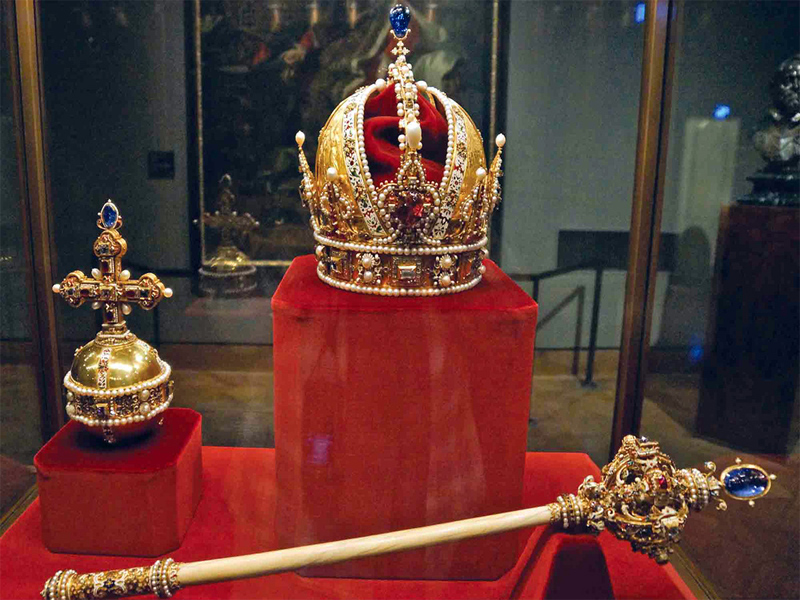The Iran National Jewelry Museum in Iran houses a collection of jewelry and precious historical artifacts from ancient times to the present day. It is situated in the basement of the Central Bank of Iran and showcases the royal and valuable jewelry and objects of the country. Visiting this museum can provide a great insight into the history and events of Iran and what has happened over time. Let’s continue with more information about this museum.
Book Iran Air flights from London to Tehran and Tehran to London with Eligasht UK:
The Plunder of Iran’s National Jewelry
Throughout the world, jewelry has been collected from ancient times until now to display power and enrich the sense of royalty. Particularly in Iran, the history of collecting valuable jewelry may be traced back to the Safavid era. After the end of the reign of Shah Sultan Hussein and the invasion of Mahmoud Afghan into Iran, the government treasures that held the jewelry were looted. Some of these jewelry, which were in the possession of the Afghan nobility, fell into the hands of Nader Shah Afshar and did not leave Iran.
Nader Shah Afshar’s Expedition to India
Although some of the jewelry had previously been transferred out of Iran, for example, one of them was in India, Nader Shah eventually decided to bring back these jewels to Iran and wrote a letter to the ruling government of India for this purpose. Although initially, the Indian court was hesitant to return the jewels to Iran, after Nader Shah’s military campaign in India, they returned a portion of these jewels along with weapons and other spoils of war to Nader Shah. He brought these jewels back to Iran, but not all of them remained in the country. According to the customs of those days, Nader Shah gave a portion of these jewels to the rulers of Iran and the kings of other countries.
Unfortunately, after the death of Nader Shah, one of his commanders looted a treasury of jewels, including the famous Kooh-e-Noor diamond. It is said that currently the Kooh-e-Noor is placed in the crown of Queen Elizabeth, the Queen of England. The present collection of the museum represents the ancient culture and tumultuous history of the Iranian nation, telling the story of the adventurous lives of past generations. On the one hand, it reflects the ancient culture and history of the Iranian people, and on the other hand, it recounts the silent tears of the oppressed and mistreated people, which resulted from the vanity and exploitation of the powerful and mighty in the past.
The value and antiquity of national jewels
The significance of the jewels in the Iran National Jewelry Museum is not limited to their economic value but rather represents the taste and craftsmanship of Iranian artisans throughout different periods of history. These jewels have served as adornments and symbols of splendor and grandeur in the courts of various rulers and also as a foundation of national power and treasury. According to foreign travelers such as Jean Baptiste Tavernier and Sir John Chardin and other European and foreign tourists, during the Safavid era, they began to collect valuable gemstones from markets in India, the Ottoman Empire, France, and Italy and transported them to Isfahan.
What we now know as the Iran National Jewelry Museum was established in 1955. The treasury spans an area of 1,000 square meters and is equipped with various security systems and locks manufactured by German experts. During the revolution, the museum was temporarily closed and reopened in 1990, and it is said that no damage was done to the jewels. Moreover, two additional gems were added to the collection in subsequent years.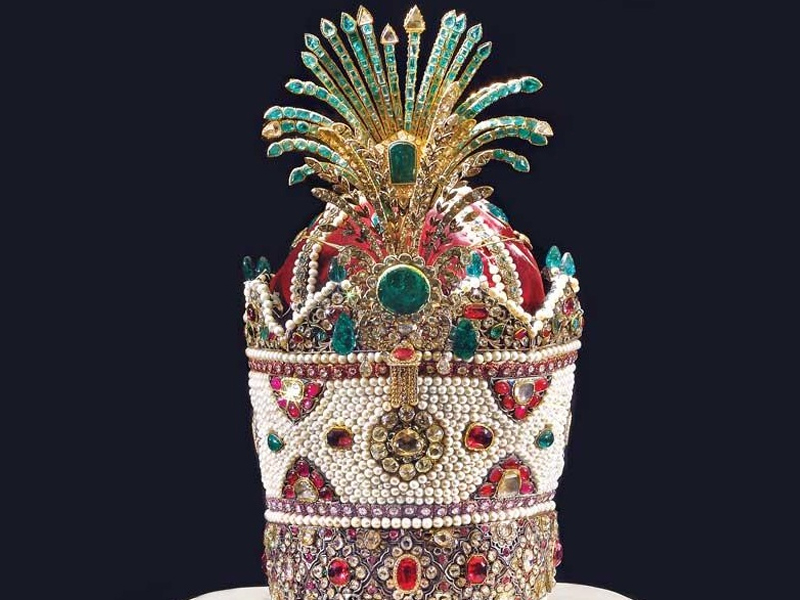
The antiquity of the valuable jewels preserved in the National Jewelry Museum of Iran dates back to prehistoric times in some cases. This signifies the importance of the National Jewelry Museum and undoubtedly, it can be said that the National Jewelry Museum of Iran is one of the most important jewelry museums in the world with international fame.
During the Pahlavi era, the jewels were appraised by a French company and donated to the Central Bank (Markazi Bank). In 1937, they were transferred to the Central Bank as a monetary reserve.
Sources for collecting national jewels
Perhaps not all national jewels can be attributed to the time of Shah Abbas the Great, as Jean Chardin, a French traveler and jeweler, says about Iranian jewels and spoils:
The collection of Iranian jewels and treasures was one of the largest and most reputable collections of valuable jewels of its time, collected from various sources, including:
1- Heritage from pre-Safavid periods that were kept in the state treasury and belonged to the kings and past conquerors.
2- From mining products obtained from Khorasan and Turkestan and the pearls of the Persian Gulf.
3- Gifts and offerings from nobles and foreign dignitaries to Iran.
4- Jewels obtained as war booty.
5- Purchasing expensive and valuable jewels and ornaments from prominent merchants such as Jean Baptiste Tavernier and Jean Chardin.
6- Buying valuable jewels from major global markets such as India, Italy, France, and the Ottoman Empire.
Prominent Artifacts of the National Jewelry Museum
The interesting and exciting part of visiting this museum is that you have to enter a vault to see these objects! There, you can see all the valuable jewels. Among all the remarkable items in this vault, the crowns and royal tiaras, thrones, brooches, precious and expensive pins, decorative jewels, and jeweled staffs are just a part of them.
It’s interesting to know that the Sea of Light Diamond, the Peacock Throne, and the Jeweled Globe, on which no price can be placed, are also part of the attractions of the National Jewelry Museum. The jewels housed in this museum are so valuable and expensive that no expert has been able to accurately or even roughly determine their value, and that’s why there is no information available about the value of these jewels.
Certainly, given what has been said, you may be curious to learn more about these jewels. In that case, pay attention to the following.
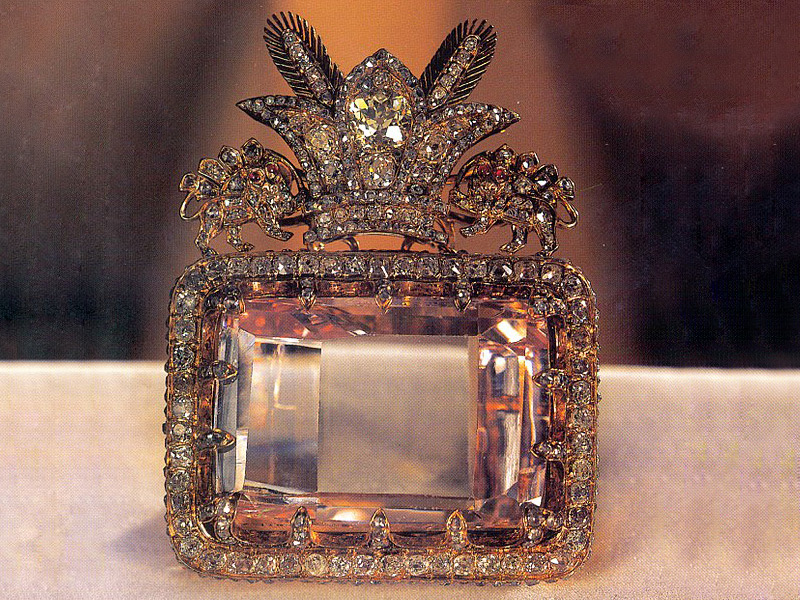
The Sea of Light Diamond ( Darya-ye Noor)
One of the most famous gemstones and diamonds in the world, with titles such as the largest, the most brilliant, and the most remarkable jewel and diamond, is the Sea of Light Diamond, which is said to have been extracted a thousand years ago. The Sea of Light Diamond, which is housed in the National Jewelry Museum, is a pink-colored jewel weighing approximately 182 carats. This diamond is one of the oldest jewels in the world and has a famous pair called the Mountain of Light (Kooh-e Noor), both of which belonged to the Nader Shah’s treasury, but now the Mountain of Light is placed on Queen Elizabeth’s Crown in England.
The Jeweled Globe
The Jeweled Globe is another famous and priceless item housed in the National Jewelry Museum of Iran, which was built by order of Naser al-Din Shah Qajar in 1291. It is said that approximately 34 kilograms of pure gold and 3,656 grams of other jewels were used in this globe. An interesting point about this globe is that, by the order of the Shah, the jewels used to create this globe were from unused jewels in the treasury. Emeralds and rubies were used in the construction of this globe to represent the sea and land, and even the equator and other geographical divisions are depicted, all of which are shown with diamonds.
Peacock Throne (Takht-e Tawous)
The Peacock Throne was commissioned by Fath-Ali Shah Qajar in 1216. The Peacock Throne, also known as the Sun Throne, is a magnificent throne made of gold and precious jewels. Its name derives from the sun image displayed at the top of the throne. The throne was originally located in the Golestan Palace until 1360 when it was transferred to the National Jewelry Museum.
Other Artifacts in the National Jewelry Museum
The National Jewelry Museum of Iran houses various categories of jewelry and treasures, including decorative jewelry, crowns and tiaras, brooches (known as jaghe), vases, food covers, hookahs, mirrors, staffs, thrones, pins, and breastplates. Some of the most notable jewels in the museum include the Sea of Light Diamond, the Peacock Throne or Sun Throne, the Naderi Throne, and the Jeweled Globe, which we have briefly discussed earlier.
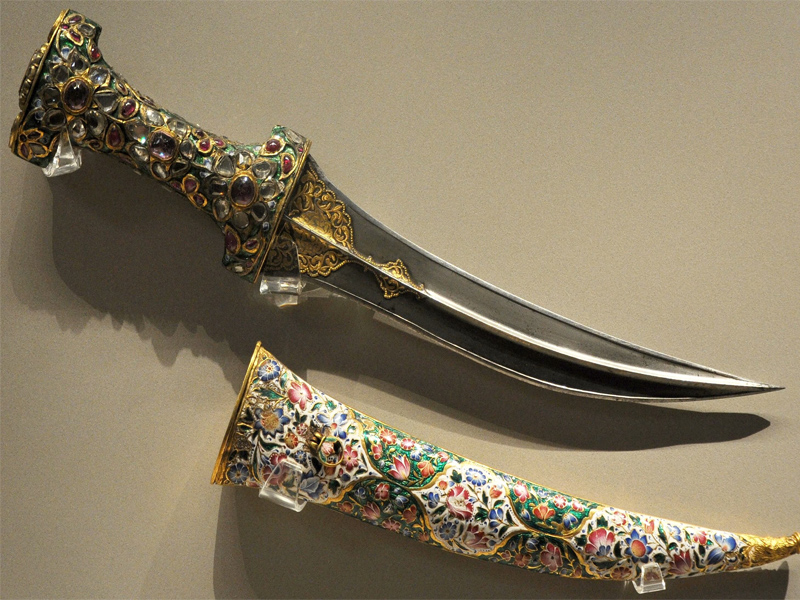
Nationalization of Iran’s Valuable Jewelry
During the reign of Reza Shah Pahlavi, the royal jewels were transferred to the underground of the Marble Palace in 1316. After the completion of the Central Bank of Iran building, a significant portion of these jewels was moved to the Central Bank Museum and served as backing for banknotes. Later, these jewels were used as collateral by the government for its debt to the bank. The new vault of the Central Bank is currently under construction in the Abbasabad Hills of Tehran.
The vault is located in the Central Bank of Iran building and also functions as a museum. Many of Iran’s royal jewels from the Safavid, Afsharid, Qajar, and Pahlavi periods are on display in this museum. These include the Sea of Light Diamond (as explained earlier), the Naderi Throne, the Pahlavi Crown of Jewels, the Kiani Crown, the Jeweled Globe, the Qajar Peacock Throne, and the Naderi Throne. The National Jewelry Museum is situated across from the Turkish Embassy on Ferdowsi Street in Tehran and is owned by the Central Bank of Iran. This treasure trove tells the story of Iran’s ancient history and culture to anyone who visits it.
Tips for Visiting the Tehran Jewelry Museum
As mentioned before, after the collection of jewelry was gathered and placed under surveillance, the visit to the museum was free for the public. However, if you have the dream of visiting this magnificent place, there are a few important points to keep in mind so that you don’t get confused or anxious during your visit to the National Jewelry Museum of Iran.
First and foremost, after booking your hotel and place of accommodation, consider a suitable time to visit the museum during its working hours, so that you don’t arrive earlier or later than the designated time for your visit to the National Jewelry Museum of Iran.
On the other hand, do not forget that carrying a camera or even a mobile phone inside the National Jewelry Museum is prohibited. Make sure that all the conditions set for visiting this valuable place contribute to the security of this cultural complex and are in the best interest of us and our country.
By the way, the final point regarding entry to the National Jewelry Museum of Iran is that the visit is only for individuals over the age of 12, and children are not allowed to enter.
Related post
Introduction to the Best Vegetarian Restaurants in Tehran
Discover the Vibrant Arab Neighborhood in Tehran
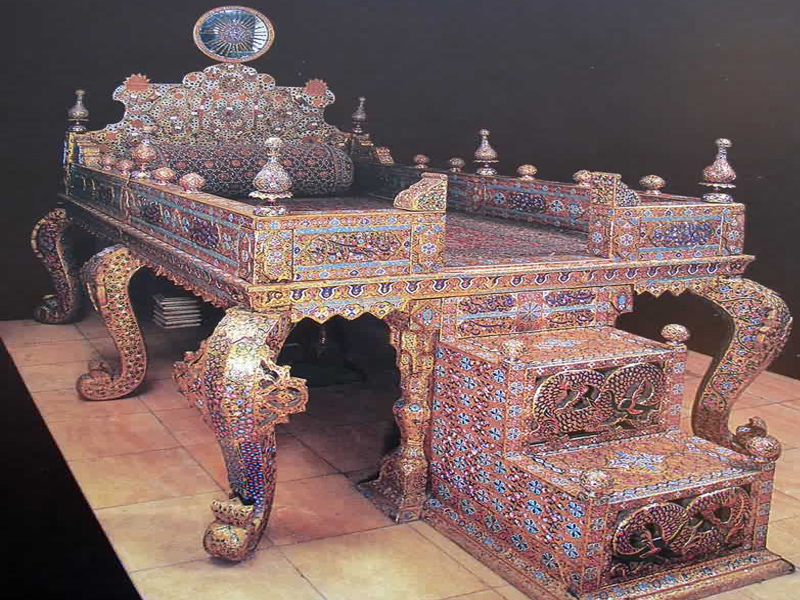
Visiting time for the National Jewelry Museum of Iran
Due to the high value of the artworks in the museum and security considerations, the National Jewelry Museum of Iran has more limited visiting hours compared to other museums in Tehran.
The National Jewelry Museum is open from Sunday to Wednesday. Visiting this museum takes place from 2:00 PM to 4:30 PM.
How to get to the National Jewelry Museum?
You, as fans of museums and Iranian history enthusiasts, can visit the National Jewelry Museum of Iran in two ways.
If your plan includes using the metro, you should first get off at Imam Khomeini Metro Station, which you can easily reach from two other metro lines.
After Imam Khomeini Street, you will reach the beginning of 30 Tir Street, and on Professor Rowland Street, you will notice the building of the National Jewelry Museum of Iran.
On the other hand, you can drive to this location with your private car, but you may encounter traffic. For better security, it is advisable to use public transportation, including the metro, to get around. We wish you an enjoyable and memorable visit.
Final words
The Iran National Jewelry Museum stands as a testament to Iran’s rich history, artistic excellence, and cultural heritage. Its remarkable collection of jewelry and precious gemstones offers a glimpse into the opulence of the Persian monarchy and the mastery of Iranian craftsmen throughout the ages. By preserving and promoting these treasures, the museum ensures that future generations can continue to appreciate and learn from Iran’s remarkable cultural legacy.
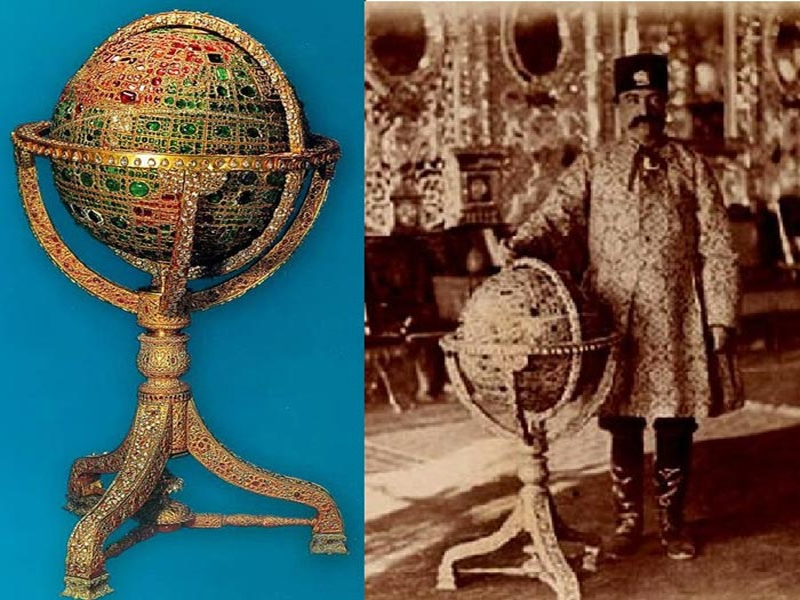
FAQ
Certainly! Here are four frequently asked questions about the Iran National Jewelry Museum:
1- Where is the Iran National Jewelry Museum located?
The Iran National Jewelry Museum is located in Tehran, the capital city of Iran. Specifically, it is situated on Ferdowsi Avenue, in the vicinity of the Central Bank of Iran.
2- What can visitors expect to see at the Iran National Jewelry Museum?
At the Iran National Jewelry Museum, visitors can expect to see a remarkable collection of exquisite jewelry and precious gemstones. The museum houses an extensive collection of historical artifacts, including the Darya-i-Noor diamond, the Naderi Throne, the Peacock Throne, and the jewel-encrusted Globe of Jewels, among many other stunning pieces.
3- Are there any restrictions on what visitors can bring into the museum?
To ensure the security and preservation of valuable artifacts, visitors are generally not permitted to bring large bags, backpacks, or suitcases into the Iran National Jewelry Museum. It is advisable to leave such items in designated storage areas or lockers provided by the museum. Additionally, visitors may be asked to pass through security checks before entering the exhibition halls.
